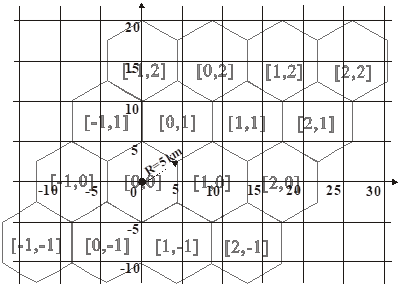2017 ACM-ICPC 亚洲区(南宁赛区)网络赛-I-GSM Base Station Identification(线性变换)
来源:互联网 发布:js 数组对象合并 编辑:程序博客网 时间:2024/05/29 23:44
In the Personal Communication Service systems such as GSM (Global System for Mobile Communications), there are typically a number of base stations spreading around the service area. The base stations are arranged in a cellular structure, as shown in the following figure. In each cell, the base station is located at the center of the cell.

For convenience, each cell is denoted by [i, j]. The cell covers the origin is denoted by [0, 0]. The cell in the east of [0, 0] is denoted by [1, 0]. The cell in the west of [0, 0] is denoted by [−1, 0]. The cell in the northeast of [0, 0] is denoted by [0, 1]. The cell in the southwest of [0, 0] is denoted by [0, −1]. This notation can be easily generalized, as shown in the above figure.
Now the question is as follows. We have a service area represented by a Euclidean plane (i.e., x−y plane). Each unit is 1 Km. For example, point (5, 0) in the plane means the location at a distance of 5 Km to the east of the origin. We assume that there are totally 400 cells, denoted by [i, j], i = −9 ... 10, j = −9 ... 10. The base station of cell [0, 0] is located at the origin of the Euclidean plane. Each cell has a radius of R = 5 Km, as shown in the following figure.
You are given an input (x, y), which indicates a mobile phone’s location. And you need to determine the cell [i, j] that covers this mobile phone and can serve this phone call.
For example, given a location (10, 0), your program needs to output the cell [1, 0], which can cover this location. Specifically, the input and output are:
- input = (x, y). hhis is a location on the Euclidean plane. This value will not exceed the service area covered by the 400 cells. That is, you do not need to handle the exceptional case that the input is out of the boundary of the service area.
- output = [i, j]. One of the 400 cells that covers location [i, j]
Input Format
A list of 10 locations.
Output Format
A list of 10 cells covering the above 10 locations in the correct order.
Please be reminded that there exist a space between coordinates.
样例输入
1 00 152 013 75 510 1525 15-13 -812 -7-10 0
样例输出
[0,0], [-1,2], [0,0], [1,1], [0,1], [0,2], [2,2], [-1,-1], [2,-1], [-1,0]
题目来源
2017 ACM-ICPC 亚洲区(南宁赛区)网络赛
题意:给你10个坐标,问你这10个点在哪个正六边形内。
题解:一开始感觉是个超级麻烦的暴力啊,比赛时室友做的这道题,说是线性变换,然而线代早忘得
一干二净了,用线性变换的话就很简单了,将每个正六边形的中心点变换到普通的二维坐标系上就OK了。
我们可以看图找出变换关系式,剩下的就是再正常不过的枚举了。。。。
#include<set> #include<map> #include<stack> #include<queue> #include<vector> #include<string> #include<time.h>#include<math.h> #include<stdio.h> #include<iostream> #include<string.h> #include<stdlib.h> #include<algorithm> #include<functional> using namespace std; #define ll long long #define inf 1000000000 #define mod 1000000007 #define maxn 1360100#define lowbit(x) (x&-x) #define eps 1e-9int a[15],b[15];int main(void){int i,j,t;double x,y,xx,yy;for(t=1;t<=10;t++){scanf("%lf%lf",&x,&y);x/=5;y/=5;for(i=-9;i<=10;i++)for(j=-9;j<=10;j++){yy=3.0/2*j;xx=i*sqrt(3.0)+j*sqrt(3.0)/2;if((xx-x)*(xx-x)+(yy-y)*(yy-y)<=1)a[t]=i,b[t]=j;}}for(i=1;i<10;i++)printf("[%d,%d], ",a[i],b[i]);printf("[%d,%d]\n",a[10],b[10]);return 0;}- 2017 ACM-ICPC 亚洲区(南宁赛区)网络赛-I-GSM Base Station Identification(线性变换)
- 2017 ACM-ICPC 亚洲区(南宁赛区)网络赛 I.GSM Base Station Identification
- 2017 ACM-ICPC 亚洲区(南宁赛区)网络赛 GSM Base Station Identification 线性变换||计算几何
- 2017 ACM-ICPC 亚洲区(南宁赛区)网络赛 I GSM Base Station Identification(暴力,计算几何)
- 2017 ACM-ICPC南宁网络赛: I. GSM Base Station Identification(线性变换)
- 2017南宁网络赛 I. GSM Base Station Identification 暴力
- 2017 ACM-ICPC 亚洲区(南宁赛区)网络赛
- 2017 ACM-ICPC 亚洲区(南宁赛区)网络赛
- 2017 ACM-ICPC GSM Base Station Identification
- 2017 ACM-ICPC 亚洲区(南宁赛区)网络赛
- ACM 2017 ACM-ICPC 亚洲区(南宁赛区)网络赛 B. Train Seats Reservation
- 2017 ACM-ICPC 亚洲区(南宁赛区)网络赛 B.Train Seats Reservation(模拟)
- 2017 ACM-ICPC 亚洲区(南宁赛区)网络赛 F. Overlapping Rectangles(扫描线)
- 2017 ACM-ICPC 亚洲区(南宁赛区)网络赛: F. Overlapping Rectangles(线段树)
- 2017 ACM-ICPC 亚洲区(南宁赛区)网络赛 F. Overlapping Rectangles(面积并)
- 2017 ACM-ICPC 亚洲区(南宁赛区)网络赛 A. Weather Patterns(阅读题)
- 2017 ACM-ICPC 亚洲区(南宁赛区)网络赛 Overlapping Rectangles
- 2017 ACM-ICPC 亚洲区(南宁赛区)网络赛 The Heaviest Non-decreasing Subsequence Problem
- Ubuntu 16.04如何禁用IPv6功能
- FYN 算法学习1~
- 如何轻松查看JAR包下的class源代码文件
- 归并排序
- Springboot中Spring-cache与redis整合
- 2017 ACM-ICPC 亚洲区(南宁赛区)网络赛-I-GSM Base Station Identification(线性变换)
- 第四周项目三
- Android网络:发送http请求
- 【51Nod1765】谷歌的恐龙
- Mac系统之----教你怎么显示隐藏文件,或者关闭显示隐藏文件
- 怎么会有两个“原本”
- C++中链表的创建、输出、节点删除、节点插入、翻转、清空
- 深浅拷贝与写时拷贝的简单认知
- mysql Community Server 5.7安装教程以及常见错误


